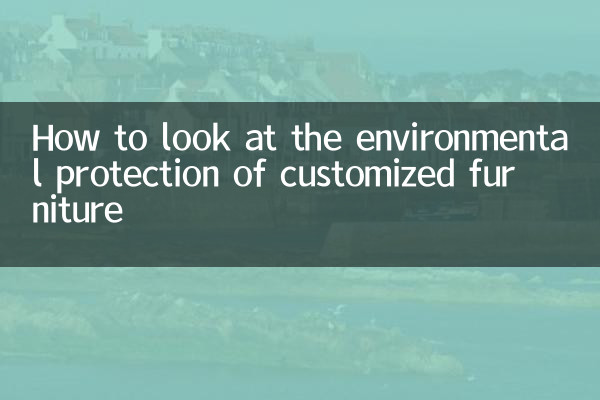What do you think about the environmental protection of customized furniture?
In recent years, with the improvement of consumers' environmental awareness, the environmental protection of customized furniture has become a hot topic. This article will combine the hot content of the entire Internet in the past 10 days to analyze the environmental protection of customized furniture from the aspects of materials, processes, certification standards, etc., and provide structured data for reference.
1. The core focus of environmental protection of customized furniture

According to recent search data, consumers’ concerns about the environmental protection of customized furniture mainly focus on the following aspects:
| focus | Proportion (discussion popularity in the past 10 days) |
|---|---|
| Board environmental protection grade | 45% |
| Adhesive safety | 30% |
| Paint/VOC emissions | 15% |
| Production process pollution | 10% |
2. Performance comparison of mainstream environmentally friendly boards
Judging from recent industry reports and consumer discussions, the following four types of boards have received the most attention:
| Board type | Formaldehyde release | Price range (yuan/㎡) | Applicable scenarios |
|---|---|---|---|
| ENF grade formaldehyde-free board | ≤0.025mg/m³ | 200-400 | Children's room, bedroom |
| F4 star plate | ≤0.03mg/m³ | 150-300 | Living room, study room |
| E0 grade plate | ≤0.05mg/m³ | 100-250 | kitchen, balcony |
| E1 grade board | ≤0.124mg/m³ | 80-200 | temporary furniture |
3. How to identify environmentally friendly customized furniture
According to recent expert advice and consumer experience sharing, you can identify it through the following methods:
1.See certification: Require merchants to provide CMA certified test reports, focusing on indicators such as formaldehyde and benzene series.
2.smell: High-quality environmentally friendly boards have only a slight wood smell. The pungent smell may mean that pollutants exceed standards.
3.Check the process: The quality of edge sealing directly affects formaldehyde release. High-quality products use PUR edge sealing technology to achieve better sealing.
4.Ask for details: Understand key information such as adhesive type (MDI glue is better than urea-formaldehyde glue), paint brand (water-based paint is more environmentally friendly).
4. Evaluation of recent popular environmentally friendly customized furniture brands
Based on the popularity of consumer discussions in the past 10 days, the following brand reputation rankings have been compiled:
| brand | Environmental highlights | consumer satisfaction |
|---|---|---|
| Brand A | All series of ENF grade boards | 92% |
| Brand B | MDI glue + water-based paint | 88% |
| C brand | F4 star imported board | 85% |
| D brand | Plant-based adhesive | 83% |
5. Suggestions for purchasing environmentally friendly customized furniture
1.Select by space: ENF grade is preferred for bedrooms, and moisture-proof boards of grade E0 or above are available for kitchens.
2.Pay attention to service: High-quality brands will provide free formaldehyde testing services, and some support third-party re-inspection.
3.Reasonable budget: The price of environmentally friendly furniture is usually 20-30% higher than that of ordinary products. It is recommended to focus on investing in bedroom furniture.
4.Later maintenance: Even if environmentally friendly materials are used, it is recommended that new furniture be ventilated for 3-6 months and used with an air purifier.
Conclusion
Choosing environmentally friendly customized furniture requires comprehensive consideration of materials, craftsmanship, certification and other factors. It is recommended that consumers do their homework before purchasing, give priority to big brands with transparent environmental protection information, and pay attention to post-processing measures such as ventilation, so as to truly realize a green home life.

check the details

check the details